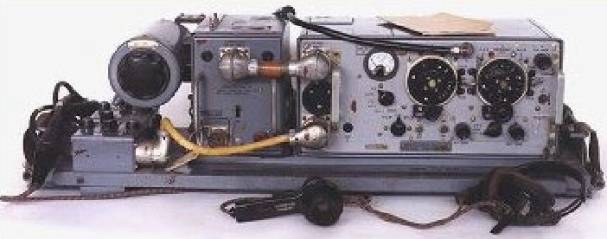Ron Levett's memories of joining up and training in the Royal Armoured Corps during World War II. My main training was as a Wireless Operator, but all crewmembers were trained in each other's trade. Wireless training consisted of RT Procedure (radiotelephony or speech), the Morse code and the tuning and operating of the Wireless Set No.19. This radio had been designed as a joint Anglo-American effort, using the then very modern octal valves. It was built in large quantities in Britain, America and Canada. They were fitted in all British and Canadian armoured vehicles and a large proportion of soft-skinned vehicles as well. They were also supplied to the Free French. The radios built in Canada had dual dial markings in English and Russian in order to supply radio sets to the Red Army. 
The 19 set consisted of three units in one case. The 'A' set was a short-wave transceiver (Transmitter/receiver). When the receiver is tuned it automatically tunes the transmitter. When the set is switched to 'send', the operator then tunes the Power Amplifier and the variometer for maximum aerial current. This is required because the length of the aerial can be varied, depending on operating conditions. When a vehicle is moving two four-foot sections were used, but for static use, sixteen feet could be fitted. The range of transmissions varied according to meteorological conditions but in mobile use would be around twenty miles. The 'B' set was a VHF transceiver operating at 235mc/s, and provided line of sight communication between tanks. The aerial in this instance was about two feet in length. The use of VHF at this time was unusual and was only made possible by the use of a new type of valve, recently developed in America. The remaining unit in the equipment was the intercom (IC). This provided communication between members of the crew. In a tank, control boxes are fitted in the turret; one for the operator plus one combined for the tank commander and gunner. A further box is fitted in the hull for the driver and co-driver. There were three models of power units made for the 19 set. The MK1 and 3 were made in England, which were very noisy when the tank's engine was switched off. The MK2 was made in Canada and was fitted with a vibrator system that only produced a low hum. When an operator was on duty at night, this was the much-preferred model. If extra range was required, the 19 set could be fitted with a booster. This increased the output by around fifty percent. The tanks in RHQ were normally fitted with this type of set in the hull gunners' position, operated by a Royal Signals operator and known as a 'Rear Link' set. This provided communication between RHQ and Brigade HQ. The 19 set could also be used for Morse transmissions as well as Radio Telephony (speech), so all operators were taught Morse up to ten or twelve words per minute. All operators were required to learn 'RT Procedure', the correct speech for use on the air. We were taught to be concise and accurate. We also had to learn the correct order for stations to answer because of the risk of jamming when two stations attempted to transmit simultaneously. Once operators were up to a certain standard, they were introduced to the Wireless No. 38. This was a dry battery operated portable designed principally for infantry use. Certain tanks, however, were fitted with these sets so that the tank commander could talk to the infantry. When carried by an operator the set is strapped on the chest. Headphones are worn plus a throat microphone known as a laryngaphone, leaving the operators hands free. With a long rod aerial sticking up in the air we felt a lot of idiots walking round Bovington talking to ourselves! Ron Levett, 2001
| 

